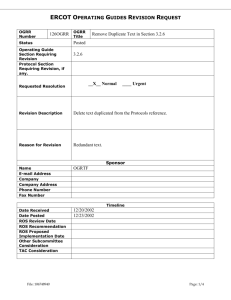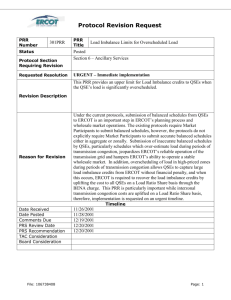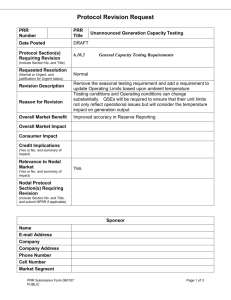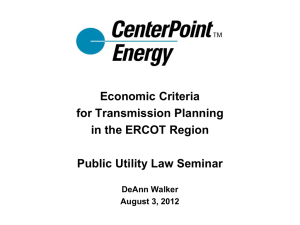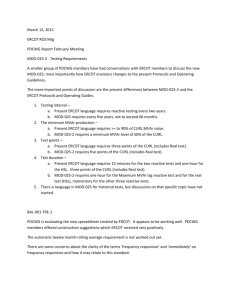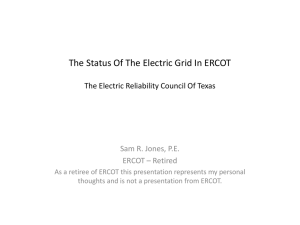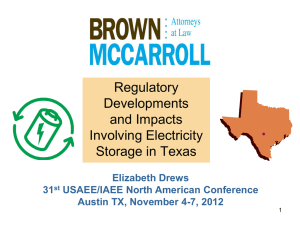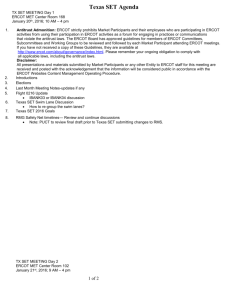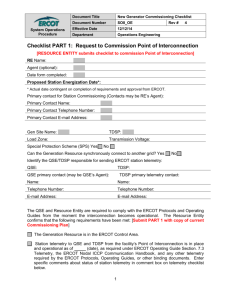Responsibility Transfers-redline
advertisement
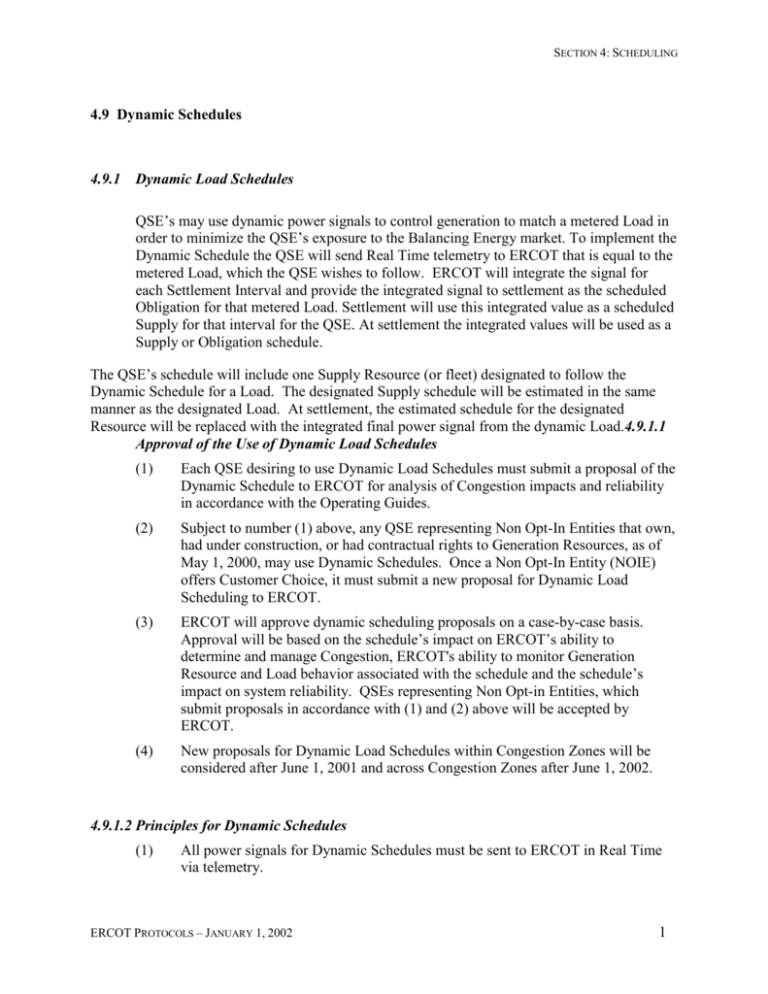
SECTION 4: SCHEDULING 4.9 Dynamic Schedules 4.9.1 Dynamic Load Schedules QSE’s may use dynamic power signals to control generation to match a metered Load in order to minimize the QSE’s exposure to the Balancing Energy market. To implement the Dynamic Schedule the QSE will send Real Time telemetry to ERCOT that is equal to the metered Load, which the QSE wishes to follow. ERCOT will integrate the signal for each Settlement Interval and provide the integrated signal to settlement as the scheduled Obligation for that metered Load. Settlement will use this integrated value as a scheduled Supply for that interval for the QSE. At settlement the integrated values will be used as a Supply or Obligation schedule. The QSE’s schedule will include one Supply Resource (or fleet) designated to follow the Dynamic Schedule for a Load. The designated Supply schedule will be estimated in the same manner as the designated Load. At settlement, the estimated schedule for the designated Resource will be replaced with the integrated final power signal from the dynamic Load.4.9.1.1 Approval of the Use of Dynamic Load Schedules (1) Each QSE desiring to use Dynamic Load Schedules must submit a proposal of the Dynamic Schedule to ERCOT for analysis of Congestion impacts and reliability in accordance with the Operating Guides. (2) Subject to number (1) above, any QSE representing Non Opt-In Entities that own, had under construction, or had contractual rights to Generation Resources, as of May 1, 2000, may use Dynamic Schedules. Once a Non Opt-In Entity (NOIE) offers Customer Choice, it must submit a new proposal for Dynamic Load Scheduling to ERCOT. (3) ERCOT will approve dynamic scheduling proposals on a case-by-case basis. Approval will be based on the schedule’s impact on ERCOT’s ability to determine and manage Congestion, ERCOT's ability to monitor Generation Resource and Load behavior associated with the schedule and the schedule’s impact on system reliability. QSEs representing Non Opt-in Entities, which submit proposals in accordance with (1) and (2) above will be accepted by ERCOT. (4) New proposals for Dynamic Load Schedules within Congestion Zones will be considered after June 1, 2001 and across Congestion Zones after June 1, 2002. 4.9.1.2 Principles for Dynamic Schedules (1) All power signals for Dynamic Schedules must be sent to ERCOT in Real Time via telemetry. ERCOT PROTOCOLS – JANUARY 1, 2002 1 SECTION 4: SCHEDULING (2) Each Dynamic Load Schedule must be tied to a Load meter or group of Load meters. This includes Load that is calculated by subtracting interchange telemetry from actual generation telemetry, appropriately adjusted for T&D Losses. A Load or group of Loads that is/are dynamically scheduled can only be followed by Generation Resources represented by the same QSE as the Load. (3) Each Dynamic Load Schedule will indicate the dynamic power signal that will be used to create the final schedule (4) Dynamic Load Schedules tied to Load meters (or groups of Load meters) may be used between Congestion Zones (5) A QSE using Dynamic Load Schedules shall send a dynamic power signal or signals to ERCOT. (6) Each QSE with a Dynamic Load Schedule will include in its schedules and plans submitted to ERCOT, an estimate for the integration of the schedule for each Settlement Interval. These schedule integration estimates will be used for allocation of RPRS costs. (7) ERCOT will integrate the dynamic power signal sent by a QSE for each Settlement Interval. This integrated signal shall replace the estimate and will be used in settlement as the final schedule. Dynamic Schedules do not alter the settlement process for metered Loads. (8) If a signal is lost for any reason, ERCOT will use the final schedule for Settlement purposes. (9) ERCOT will use the dynamic power signal in each of the applicable QSE’s SCE equation. 4.9.2 Responsibility Transfers (RT) 4.92.1 Approval of the Use of Responsibility Transfers (1) Intra-zonal Responsibility Transfers (RT) will be approved unless ERCOT determines it cannot accommodate these transfers without compromising reliability or settlement accuracy. (2) Each QSE that proposes to use an RT must submit a proposal of the RT to ERCOT for analysis of Congestion impacts and reliability in accordance with the Operating Guides. The proposal for each RT shall identify: 1) Controlling Entity, 2) Following Entity, 3) Congestion Zone, 4) maximum value, 5) units supplying energy, and 6) other information required by ERCOT. 4.9.2.2 Principles for Responsibility Transfers (1) RT may be used to shift responsibility for Supply of a defined maximum amount of MWs from one QSE to another QSE within the same Congestion Zone after the close of the adjustment period. As the RT changes the responsibility for supply of one QSE there must be an equal and opposite change in the responsibility for Supply of the other QSE (2) One of the QSEs will act as the controller of the Real Time Dynamic signal. That ERCOT PROTOCOLS – JANUARY 1, 2002 2 SECTION 4: SCHEDULING Controlling Entity (CE) will send a Real Time power signal to ERCOT representing that QSE’s power commitment to the other QSE, the Following Entity (FE). (4) (3) ERCOT will use the dynamic power signal from the CE in its calculation of the CE’s SCE. ERCOT will also use the dynamic power signal from the CE to calculate an equal and opposite value to use in calculation of the FE’s SCE. The FE will use a signal from the CE to calculate its (the FE’s) SCE. ERCOT will integrate the dynamic power signal from the CE for each Settlement Interval and use this value as an offset in the CE’s settlement for resource imbalance. An equal but opposite offset will be used in the FE’s settlement for resource imbalance. (5) If the signal from the CE is lost, ERCOT will use the last good value received from the CE until the CE manually replaces the value, or the signal is restored. 4.9.3 Responsibility Transfer for Balancing Energy Bidding Certain PUCT mandated Capacity Auction Products (as defined in PUCT S.R. §25.381) allow the entitlement holder (Buyer) to provide Balancing Energy Service to ERCOT whenever a Responsibility Transfer (“RT”) between Buyer and Seller’s respective QSEs is established. The procedure for providing Balancing Energy from Capacity Auction Products is set forth in Protocols Section 6.5.2.1, Balancing Energy Service Bids from Bilateral Contracts. ERCOT PROTOCOLS – JANUARY 1, 2002 3
